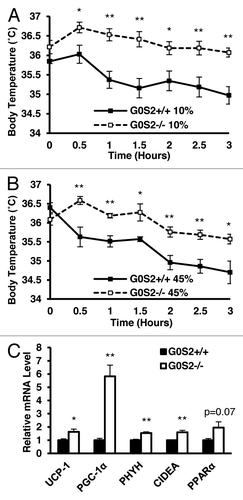Figures & data
Figure 1. Generation of G0S2−/− mice. (A) Targeting strategy of G0S2−/− mice. Homologous recombination of the targeting vector with the wild type (WT) allele resulted in the replacement of the G0S2 coding region with a lacZ and loxP-flanked neomycin resistance gene cassette. (B) Genotyping of WT (G0S2+/+), heterozygote (G0S2+/−), and homozygote (G0S2−/−) mice with primers for G0S2 and lacZ. (C) Immunoblot analysis of G0S2 protein expression with proteins from gonadal fat of G0S2+/+ and G0S2−/− mice. Actin served as loading control. (D) Evidence for lactation defects in G0S2−/− mice. A representative G0S2−/− pup fed with a G0S2−/− mother did not have a visible milk spot as seen in a pup nursed by a G0S2+/+ mother.
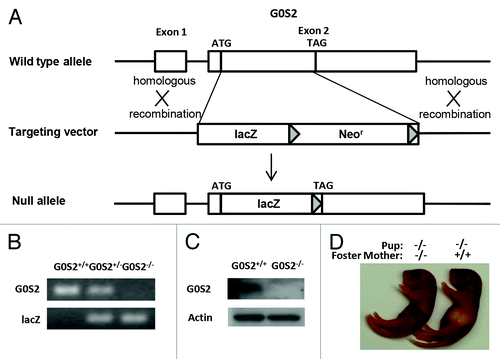
Figure 2. G0S2 tissue distribution in various organs. Organs from 3 mo old male G0S2−/− and G0S2+/+ mice were independently harvested and lacZ stainings were performed in white adipose tissue (WAT), liver, skeletal muscle, heart, kidney, and lung tissues.
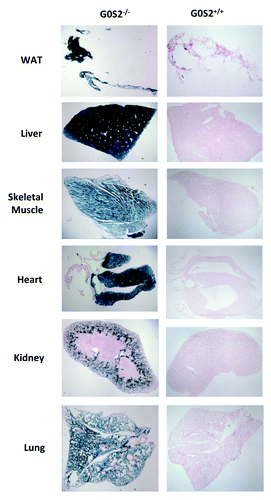
Figure 3. G0S2−/− mice showed decreased relative body weight and decreased fat pad weight. (A and B) Relative body weight as compared with initial body weight (8 wk of age) of male G0S2+/+ and G0S2−/− mice during 14 wk fed on a 10% fat diet (A, upper panel) or a 45% fat diet (B, upper panel). Food intake of G0S2+/+ and G0S2−/− mice during 14 wk on a 10% fat diet (A, lower panel) and 45% fat diet (B, lower panel) (n = 12). (C and D) Organ weight (left panel) and fat pad weight (right panel) of male mice fed a 10% fat diet (C) and 45% fat diet (D) (n = 8–9). Gon Fat, gonadal fat pad; Ing Fat, inguinal fat pad; Ren fat, renal fat pad; BAT, interscapular brown adipose tissue. The symbols * and ** depict statistical significance as P < 0.05 and P < 0.01, respectively.

Figure 4. Serum glycerol and free fatty acid levels in G0S2+/+ and G0S2−/− mice. Serum from 5 mo old male G0S2+/+ and G0S2−/− mice fed with 10% fat diet were analyzed for (A) glycerol and (B) free fatty acid (n = 11–12). Data are presented as mean ± SE. The symbol * depicts statistical significance as P < 0.05.
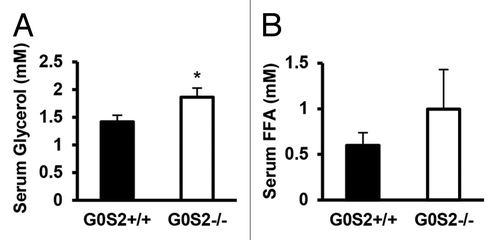
Figure 5. O2 consumption, respiratory quotient and percentage active time of G0S2−/− mice vs. G0S2+/+ mice. (A–C) Time course of (A) O2 consumption, (B) respiratory quotient, and (C) percentage active time of G0S2+/+ vs. G0S2−/− male mice fed a 10% fat diet (left panel) or a 45% fat diet (right panel) during 24 h with access to food and water ad libitum (n = 12). Data are presented as mean ± SE. The symbol * depicts statistical significance as P < 0.05.
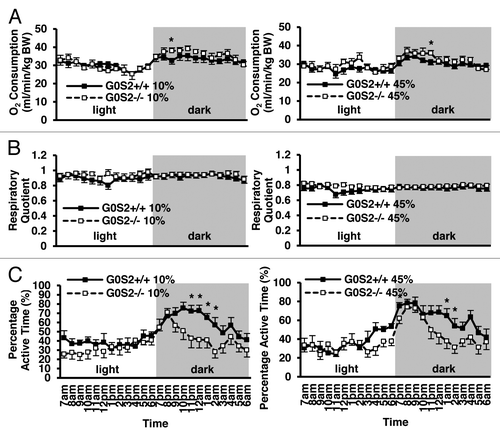
Figure 6. G0S2−/− mice had improved cold tolerance. (A and B) Body temperatures of 7-mo-old male mice fed with a 10% fat diet (A) and a 45% fat diet (B) were determined during exposure to 4 °C for 3 h (n = 7). (C) Real-time PCR analysis of gene products involved in thermogenesis and fatty acid oxidation in brown adipose tissue (BAT) of G0S2+/+ and G0S2−/− mice fed with a 10% fat diet following 3 h of cold exposure (4 °C) (n = 4). Data are presented as mean ± SE. The symbols * and ** depict statistical significance as P < 0.05 and P < 0.01, respectively.
